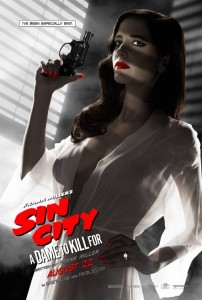Sin City: A Dame to Kill For seems to almost prey on our memories (and, for some, admiration) of 2005’s first Sin City by reintroducing many of the same shadowy characters in the same grim, gutless city and not providing a narrative motor to make the return worth it. The film not only wastes the audience’s time, but the characters’s as well. Without injecting urgency to each plodding minute, A Dame to Kill For wades in murky visuals that only serve to reinforce the film’s muddy themes.
“A Dame to Kill For”, a hyperbolic line from the original graphic novels that emphasizes the potency of a femme fatale’s beauty, is made less hyperbolic by Robert Rodriguez and Frank Miller’s grim and ultra-violent depiction of a fictionalized, nocturnal city torn apart by sadistic crime, corruption, and all-out lawlessness. Rodriguez and Miller, who co-directed the picture, choose not to effectively challenge such amorality through the vengeful motivations of their antiheroes. Instead, the film sinks in its own nihilism and refuses to get fun. The movie isn’t only empty; it’s entirely joyless.
A Dame to Kill For, solely written by Miller, is not without the occasional punchy riffs of voiceover and dialogue, which often describe disturbed psychological states and moments of unimaginable pain. But since Miller is, as usual, crafting his narrative with fixed archetypes, the descriptions are at the service of a stylistic exercise, which only imitate the cool elements of film noir and don’t add genuine dimension to the story. It’s Tarantino’s same problem – always will be, methinks – but at least that man is at his best when he gets charismatically, and casually, irreverent towards the pushing of genre tropes.
On the other hand, Miller-Rodriguez take on a flat, humourless attitude towards telling this derivative revenge tale. Lacking energy, A Dame to Kill For is not loaded with the sense of unstoppable anger and passion that ought to fuel an antihero’s drive to kill for a dame of unbridled beauty. Miller-Rodriguez create characters who are vessels of impenetrable attitude. Even if we don’t understand them, we should acknowledge their outlook on their amoral environment, instead of passively listening to gruff voiceover that keeps trying to one-up itself with sardonic statements.
The movie is strung together by four vignettes- “Just Another Saturday Night”; “The Long Bad Night”; “A Dame to Kill For”; and “Nancy’s Last Dance”. There are some returning characters, such as the brutish Marv (Mickey Rourke); the formidable sexpot Gail (Rosario Dawson); John Hartigan (Bruce Willis, in spectral form); and the angelic stripper Nancy Callahan (Jessica Alba) who seems to be the only character who demonstrates reluctance when it comes to performing violence.
There are new faces, including Joseph Gordon-Levitt as a cocky gambler who gets in over his head with the psychotic egomaniac Senator Roark (Powers Boothe). There’s also Eva Green, who effortlessly sheds the skin of imperious Artemisia from 300: Rise of an Empire to a new beguiling villainess whose palpable sex appeal is exploited for, sadly, fanboy enjoyment. The ultimate femme fatale, Green is mistreated as a caricature whose sexy persuasiveness feels stiff and unconvincing here.
A Dame to Kill For only works at being repetitious, repeating the same acts of gratuitous violence from crotch-crunching kicks to skull-smashing punches that turn the film into an eyesore of brutality. In every scene, violence feels inevitable and so we just wait for the next perp to get pummelled to the point white phosphorescent blood explodes out of them like glow stick fluid. The result of this gratuitousness, paired with the film’s obvious nihilism, creates a numbing agent that paralyzes our ability to get emotionally involved in any of the characters’s quests for retribution.
Rodriguez-Miller whip the camera around, crank up Rodriguez’s grungy soundtrack that seems to take from Link Ray and Jack Nitzsche (both used in Tarantino’s films, remember?), and revel in the pristinely monochromatic visuals that put the “neo” back in neo-noir— but to what end? There’s not enough story here to excuse the empty feelings, nor enough emotional urgency to reconcile the morose, low-key pacing.
Sin City: A Dame to Kill For is an unearned exercise in style, without the rhyme, rhythm or reason to welcome back our revenge-hungry protagonists sick of the city that, in a hideous stroke of bad luck, gave birth to them.
**********
Read more of Parker Mott’s reviews at ‘The Final Take with Parker Mott’





Leave a comment